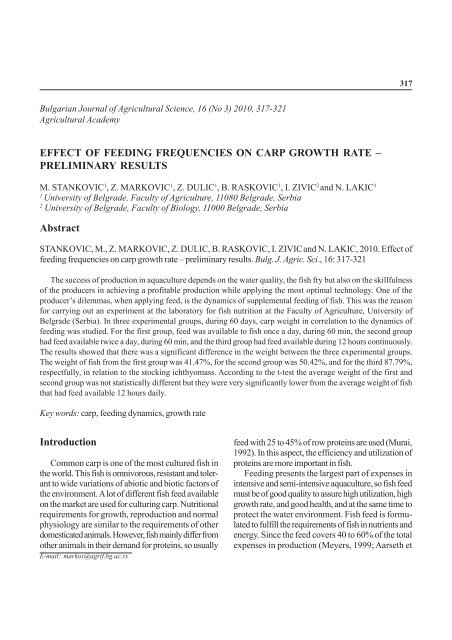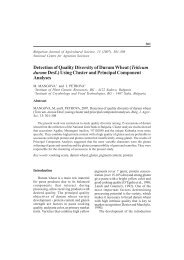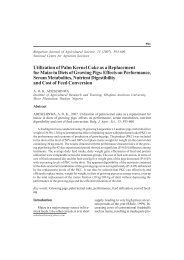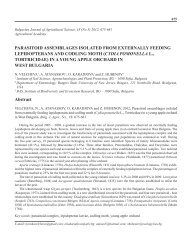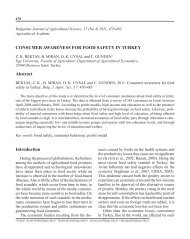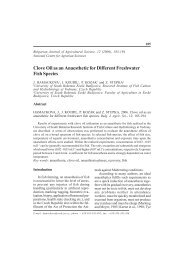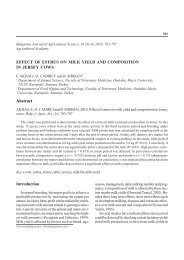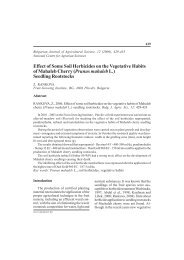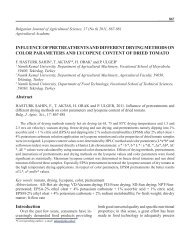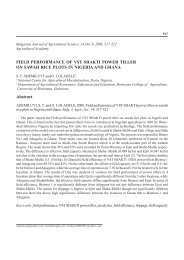EFFECT OF FEEDING FREQUENCIES ON CARP ... - ResearchGate
EFFECT OF FEEDING FREQUENCIES ON CARP ... - ResearchGate
EFFECT OF FEEDING FREQUENCIES ON CARP ... - ResearchGate
You also want an ePaper? Increase the reach of your titles
YUMPU automatically turns print PDFs into web optimized ePapers that Google loves.
318 M. Stankovic, Z. Markovic, Z. Dulic, B. Raskovic, I. Zivic and N. Lakical., 2006), the prices present a very important factorin formulating fish diets. However, cheap alternativesto the most expensive fish feed, fishmeal, are found.Soy proteins are the most used substitution for fishmealdue to the high protein content and a similar aminoacid composition, medium price and constant availabilityat the market (Storebakken et al., 2000). Inthe trend of global increase of production in aquaculture,there is a demand for introduction of new componentsin fish diets (Tacon, 2005; Kraugerud, 2008)and their maximal utilization. The diets are also enricheswith feeding stimulants, flavors and emulators.For some species and size categories of fish, anadequately composed diet (Watanabe, 2002;Ruohonen et al., 2004; Bruce et al., 1999) is the mostimportant prerequisite for good growth. However,except the diet composition, very significant differencesin feeding regimes are found (Yamamoto et al.,2007).In the semi intensive system of culturing, the dominanttype of carp production in Serbia, the fish feedmainly consists of row cereals. Nowadays, with gainingknowledge on the quality of compound feeds, producersare substituting cereals with pelleted feed andfurthermore with extruded feed.Since carp are usually cultured in rather big earthenponds, fish are hand fed from the boat once, rarelytwice a day. Aiming to increase the production, a smallgroup of carp producers have installed feeders inearthen ponds that provide food for fish during thewhole day.The aim of this paper was to determine the interdependencebetween the growth rate of carp and differentfeeding frequencies using the same feed.Material and MethodsThe trial was conducted at the Laboratory for fishnutrition of the Faculty of Agriculture, University ofBelgrade and lasted for 60 days. Two year old carp(Cyprinus carpio) used in the experiment were obtainedfrom the fish farm DTD Ribarstvo “Jazovo”.Fish were divided into three groups, with 19 fish pertank having average weight 159.2g. Extruded feedSoprofish 38/12 produced by ’’Veterinarian InstituteSubotica’’ (Serbia) with 4 mm pellets was used forthe experiment.The rearing system consisted of plastic tanks, 120l in volume, with a flow-through system of dechlorinatedwater (flow rate: 0.34 l min -1 in each tank). Oxygenconcentration in tanks was regulated with aeratorsRESUN LP-60.Every tank was equipped with a semi automatedbelt feeder AGK-Technology Gmbh (Germany). Thefirst experimental group of fish had feed available for60 minutes per day. The second group of fish hadfeed available twice a day, for 60 min., with a pauseof 120 min in-between. The third group had continuouslyavailable feed during 12 hours per day. Theamount of given feed in all tanks represented 2.5 %of the ichthyomass. Belt feeders were filled with feedevery day at the same time.Water temperature, oxygen concentration and saturationwere constantly recorded (every 10 min) usingan automatic recorder, Multi-Channel Dissolved OxygenMeter (OxyGuard, Denmark). Electrical conductivityand pH were measured weekly using a field kitMULTI 340i/SET (WTW, Welheim, Germany). Bodyweight and feed were measured using digital balanceKERN plus 2100-2 (accuracy 0.01g).The results were analyzed using descriptive andanalytical statistics. All statistical analyzes were conductedusing statistical package Statistica 6.0. Of statisticalmeasures of center, mean and median wereapplied. The variability of data was quantified usingvariation interval, standard deviation, standard errorand variation coefficient. Furthermore, significant differencesbetween average fish mass were tested. Thehomogeneity of variances was analyzed using Levene’stest and then the parametric model of analysis of variances(ANOVA) and t-test was applied.Results and DiscussionDuring the experiment, oxygen concentration wason average 5.5 mg/l with variations of ±1 mg/l perdays, in every tank, as well as between tanks. Electricalconductivity was in the range from 510 to 514μS
Effect of Feeding Frequencies on Carp Growth Rate – Preliminary Results319Table 1Minimal and maximal individual fish weightin groups at the beginning and the endof the experimentGroupsIndividual weightat the beginningIndividual weightat the endmin max min maxI 89.8 219 160 290II 118 206 155 325III 122 195 250 350cm -1 , with minimal daily variations. Water temperaturewas in the range from 21.5 to 22.5 o C.At the beginning of the experiment, the lowestweight of individual fish was 89.8 and the highest was219 g, both measured in the first group of fish (Table1).At the end of the experiment the lowest weight hadthe individuals from the second group, 155g, and thehighest had the fish from the third group, 350g.The body weight varied the most at the beginningof the experiment in the first group, and at the end ofthe experiment in the second group (Figure 1). At thebeginning and the end of the experiment, the longestinterval of variation and the interquarter differenceswere found for the body weight of the third group offish.The fish in groups had homogenous weight (Cv
320M. Stankovic, Z. Markovic, Z. Dulic, B. Raskovic, I. Zivic and N. LakicFig. 2. Mean, standard deviation and standard error for the fish weightof all three groupsand the effect of feeding frequencies on the averagefish weight was tested using ANOVA. The averageweight of experimental groups at the end of the experimentwere 225.316 g, 239.632 g and 298.526 gand were significantly different from each other(F=20.191; p
Effect of Feeding Frequencies on Carp Growth Rate – Preliminary Results321ter than the second group. The t-test showed that theaverage fish weight from the first and second groupwere not statistically different, but were significantlylower that the average fish weight of the third groupthat had feed available continuously for 12 hours perday.These results are of great significance for the improvementof feeding regimes in carp culturing and ingaining higher growth with the same amount of feed.AcknowledgementsThis research was supported by Ministry of Scienceand Technological Development, Republic ofSerbia, Belgrade under the Project TR 20047 ’’Improvementof semi-intensive carp production(Cyprinus carpio) in sustainable aquaculture’’ and EUFP7 Project „ROSA“ („Reinforcement of SustainableAquaculture“, N o 205135). The authors are alsothankful to ’’Veterinarian Institute Subotica’’ Subotica- Serbia for financial support in order to carry out thisresearch.ReferencesAarseth, K. A., M., Sorensen and T. Storebakken,2006. Effects of red yeast inclusions in diets forsalmonids and extrusion temperature on pellet tensilestrength: Weibull analysis. Animal Feed Scienceand Technology, 126: 75 – 91.Bruce, B. G. and M. G. Delbert, 1999. Dietary manipulationsaffecting growth and nitrogenous wasteproduction of red drum, Sciaenops ocellatus I. Effectsof dietary protein and energy levels. Aquaculture178: 333–348.Guinea, J. and F. Femandez, 1997. Effect of feedingfrequency, feeding level and temperature onenergy metabolism in Sparus aurata. Aquaculture,148: 125-142.Kraugerud, O. F., 2008. Physical and nutritional propertiesof polysaccharides in extruded fish feed.Norwegian University of Life Sciences, PhilosophiaeDoctor Thesis, 2008:29, ISSN: 1503-1667, ISBN:978-82-575-0832-6.Meyers, S. P., 1999. Aquafeed formulation and ingredients.In: Chang, Y. K. And Wang S. S. (eds.)Advances in extrusion technology. Aquaculture /animal feeds and foods. Technomic PublishingCompany, Inc. Lancaster, PA.USA. pp. 19-27.Murai, T., 1992. Protein nutrition of rainbow trout.Aquaculture, 100: 191-207.Ruohonen, K. and J. Kettunen, 2004. Effectiveexperimental designs for optimizing fish feeds.Aquaculture Nutrition, 10: 145 – 151.Storebakken, T., S. Refstie and B. Ruyter, 2000.Soy products as fat and protein sources in fish feedsfor intensive aquaculture. In: Drachley, J.K. (Ed.),Soy in Animal Nutrition. Fed. Anim. Sci. Soc. Savoy,IL, USA, pp. 127–170.Tacon, A. G. J., 2005. State of information on salmonaquaculture feed and the environment. AquaticFarms Ltd, 80 pp.Watanabe, T., 2002. Strategies for further developmentof aquatic feeds. Fisheries Science; 68: 242–252.Yamamoto, T., Shima, T., Furuita, H., Sugita, T.and N. Suzuki, 2007. Effects of feeding time, watertemperature, feeding frequency and dietary compositionon apparent nutrient digestibility in rainbowtrout Oncorhynchus mykiss and common carpCyprinus carpio. Fisheries Science, 73: 161 –170.


